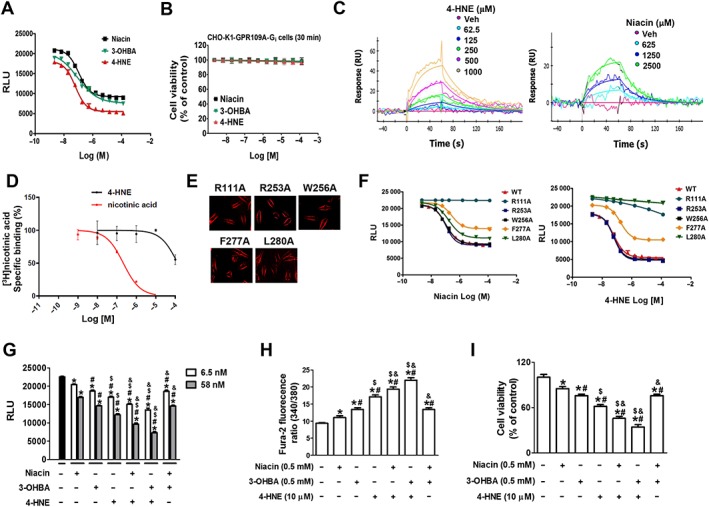Figure 7.

4‐HNE is a stronger agonist than niacin, not competing with niacin for binding sites in GPR109A. (A) A functional activity assay using the CHO‐K1‐GPR109A‐Gi cell line, which was designed to detect the inhibition of cAMP generation, was performed in the cells pre‐stimulated with forskolin prior to treatment with the other agonists. (B) 4‐HNE, niacin, 3‐OHBA did not induce cytotoxicity in CHO‐K1‐GPR109A‐Gi cells. (C) SPR binding assay showing 4‐HNE and niacin bind to GPR109A in a concentration‐dependent manner. (D) [3H]‐niacin binding competition assay with 4‐HNE and niacin showing their effects are concentration‐dependent in HEK‐293T cells stably expressing human GPR109A. (E and F) CHO‐K1 cells were transfected with five different FLAG‐tagged plasmids of GPR109A mutants (R111A, R253A, W256A, F277A and L280A). (E) Indicates their transfection efficiency as demonstrated by FLAG staining and (F) shows the results of the functional activity assay indicating that 4‐HNE and niacin decreased the forskolin‐induced production of cAMP in a concentration‐dependent manner. (G–I) Effects of combination treatments with the GPR109A ligands (niacin, 3‐OHBA or 4‐HNE). (G) CHO‐K1‐GPR109A cells were treated with a combination of two from three ligands, and forskolin‐induced cAMP levels were measured. In ARPE‐19 cells, effects of combination treatments on changes in (H) intracellular Ca2+ levels and (I) cell viability were determined. * P < 0.05 versus vehicle‐treated controls. # P < 0.05 versus niacin‐treated cells. $ P < 0.05 versus 3‐OHBA‐treated cells. & P < 0.05 versus 4‐HNE‐treated cells. RU, response units.
